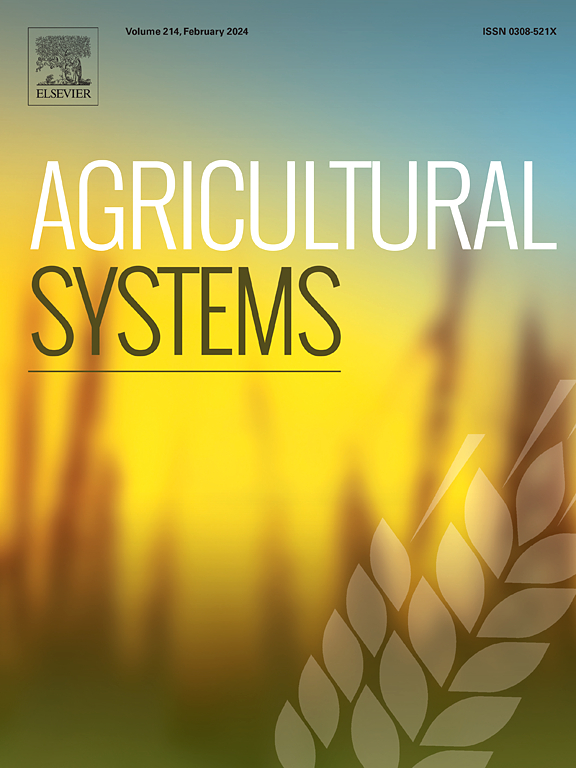欧洲农林业系统的近期时空动态
IF 6.1
1区 农林科学
Q1 AGRICULTURE, MULTIDISCIPLINARY
引用次数: 0
摘要
农林业是一种土地管理系统,将木本植被与作物和/或畜牧业生产结合起来,从生态和经济的相互作用中获益。这种系统还包括农业用地与小木本特征(SWF)相结合,如树篱、林荫树、林地和河岸缓冲带,这些通常形成田地边界。本文旨在通过确定欧盟农林业系统的当前程度,评估土地利用及其强度之间的变化和转变,并评估这些变化的可能驱动因素,来分析其时空动态。为了实现这一目标,参考LUCAS数据集,将农林业系统分为普通农林业系统(AFC)和SWF农林业系统(AFSWF)。AFC包括六种类型的系统:森林,森林可耕,农林复合,放牧永久性作物,间作永久性作物和厨房菜园。主权财富基金包括四种类型:主权财富基金可耕地作物、主权财富基金永久性作物、主权财富基金放牧草地和主权财富基金未放牧草地。在2012-2015年和2015-2022年两个时间段内,对涉及农林复合系统的土地利用变化进行了区间、分类和过渡三个层次的强度分析。结果与结论2022年欧盟农林业总面积为408073 km2(占UAA的25%),其中AFSWF系统(64%)比AFC系统(36%)分布更广,而森林系统是主导类型(占农林业总面积的29%)。近年来,农林业面积减少了36%,主要是由于农业集约化和放牧放弃造成的主权财富基金减少,其中主权财富基金永久性作物损失最大(- 56%)。厨房菜园是唯一扩大的农林业类型(24%)。法国、意大利、爱尔兰和西班牙的下降幅度最大(占地表损失的62%),而只有瑞典、匈牙利、爱沙尼亚、芬兰、捷克和斯洛伐克的地表损失有所增加。大多数转型(77%)涉及转换为其他土地用途,尽管损失率在2015年之后有所放缓。此外,18%的变化是由于从其他土地用途转为农林业,而5%涉及不同农林业类型之间的过渡。本研究使用LUCAS数据集对欧盟农林业系统分布和动态进行了最新的评估。调查结果突出了农林复合系统的持续衰退,强调需要制定政策,特别是在共同农业政策(CAP)的框架内,促进其保护和纳入可持续农业做法。通过整合强度分析,该研究增强了对土地利用转型及其驱动因素的理解,为土地管理、生态系统服务和气候适应能力提供了有价值的见解。本文章由计算机程序翻译,如有差异,请以英文原文为准。

Recent spatiotemporal dynamics of agroforestry systems in Europe
Context
Agroforestry is a land management system that integrates woody vegetation with crop and/or livestock production to benefit from ecological and economic interactions. Such systems also include agricultural land uses combined with small woody features (SWF) such as hedgerows, avenue trees, woodlots and riparian buffer strips, which often form field boundaries.
Objective
The paper aims to analyse the spatial and temporal dynamics of agroforestry systems in the EU by determining their current extent, assessing the changes and transitions among land uses and its intensity, and evaluating the likely drivers of these changes.
Methods
To achieve this, the LUCAS dataset was consulted, and the agroforestry systems categorised into common agroforestry systems (AFC) and SWF agroforestry systems (AFSWF). AFC included six types of systems: silvopastoral, silvoarable, agrosilvopastoral, grazed permanent crops, intercropped permanent crops and kitchen gardens. AFSWF included four types: SWF-arable crops, SWF-permanent crops, SWF-grazed grassland and SWF-ungrazed grassland. The intensity analysis of land use changes involving agroforestry systems was conducted at three levels: interval, categorical and transitional, across two time periods: 2012–2015 and 2015–2022.
Results and conclusions
Agroforestry systems in the EU covered 408,073 km2 (25 % of UAA) in 2022, with AFSWF systems (64 %) being more widespread than AFC systems (36 %), and silvopastoral systems as the dominant type (29 % of the total agroforestry area). Over recent years, agroforestry area declined by 36 %, mainly due to SWF reduction from agricultural intensification and grazing abandonment, with SWF-permanent crops experiencing the highest loss (−56 %). Kitchen gardens were the only agroforestry type that expanded (24 %). France, Italy, Ireland, and Spain showed the largest declines (accounting for 62 % of the surface losses), while gains were only observed in Sweden, Hungary, Estonia, Finland, Czechia, and Slovakia. Most transitions (77 %) involved conversion to other land uses, though the loss rate slowed after 2015. Additionally, 18 % of changes were due to conversions from other land uses to agroforestry, while 5 % involved transitions among different agroforestry types.
Significance
This study provides the most up-to-date assessment of agroforestry system distribution and dynamics in the EU using the LUCAS dataset. The findings highlight the ongoing decline of agroforestry systems, emphasizing the need for policies that promote their conservation and integration into sustainable agricultural practices, particularly within the framework of the Common Agricultural Policy (CAP). By integrating an intensity analysis, the study enhances the understanding of land use transitions and their drivers, offering valuable insights for land management, ecosystem services, and climate resilience.
求助全文
通过发布文献求助,成功后即可免费获取论文全文。
去求助
来源期刊

Agricultural Systems
农林科学-农业综合
CiteScore
13.30
自引率
7.60%
发文量
174
审稿时长
30 days
期刊介绍:
Agricultural Systems is an international journal that deals with interactions - among the components of agricultural systems, among hierarchical levels of agricultural systems, between agricultural and other land use systems, and between agricultural systems and their natural, social and economic environments.
The scope includes the development and application of systems analysis methodologies in the following areas:
Systems approaches in the sustainable intensification of agriculture; pathways for sustainable intensification; crop-livestock integration; farm-level resource allocation; quantification of benefits and trade-offs at farm to landscape levels; integrative, participatory and dynamic modelling approaches for qualitative and quantitative assessments of agricultural systems and decision making;
The interactions between agricultural and non-agricultural landscapes; the multiple services of agricultural systems; food security and the environment;
Global change and adaptation science; transformational adaptations as driven by changes in climate, policy, values and attitudes influencing the design of farming systems;
Development and application of farming systems design tools and methods for impact, scenario and case study analysis; managing the complexities of dynamic agricultural systems; innovation systems and multi stakeholder arrangements that support or promote change and (or) inform policy decisions.
 求助内容:
求助内容: 应助结果提醒方式:
应助结果提醒方式:


